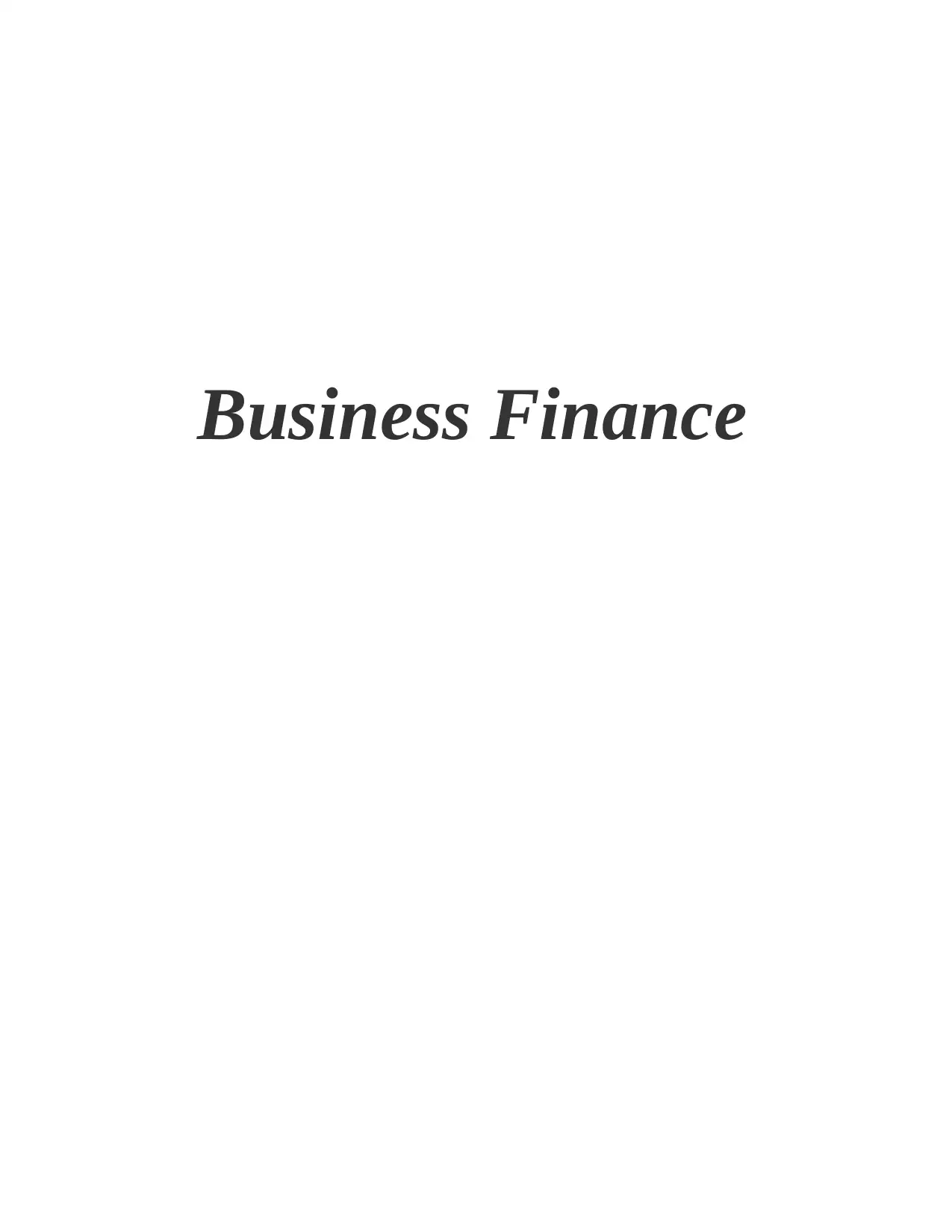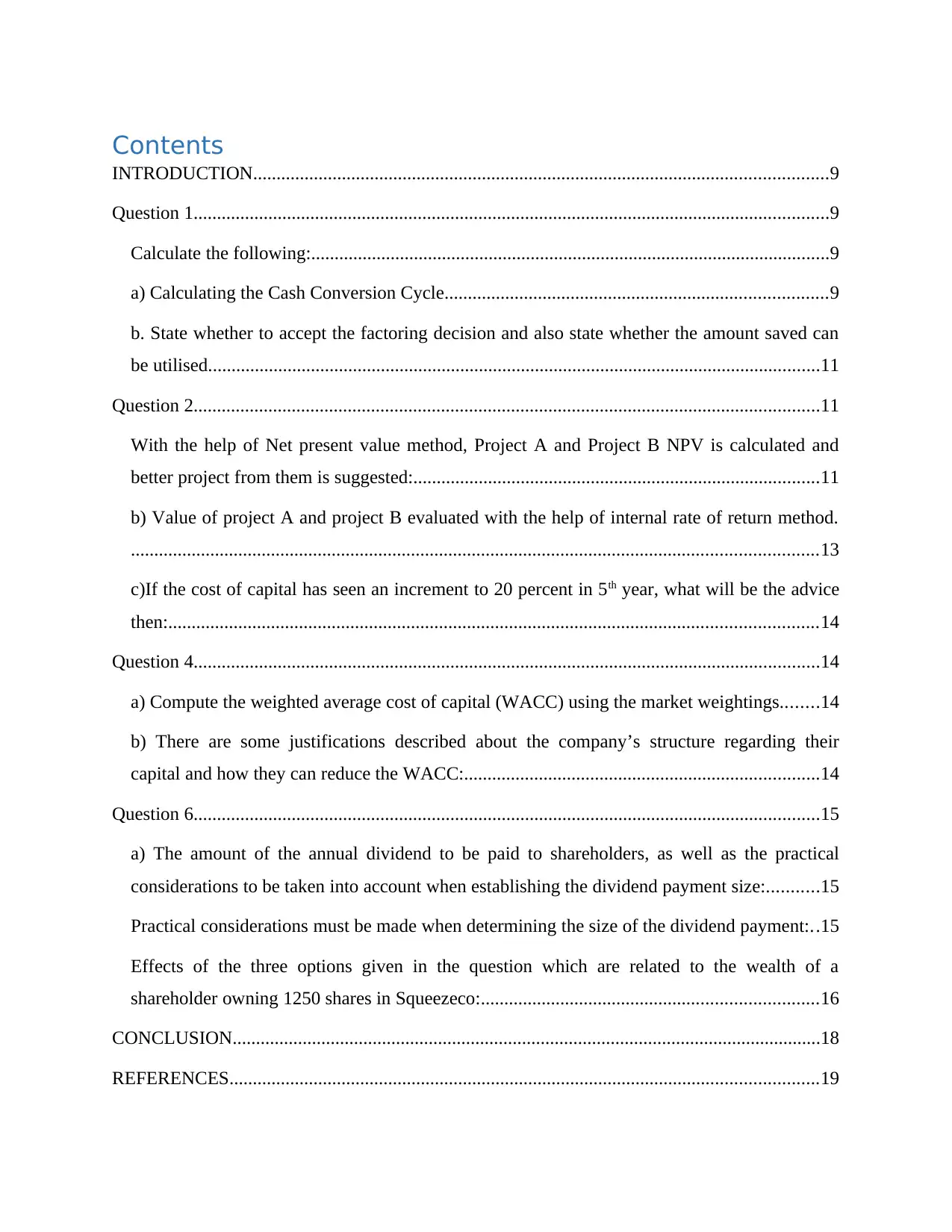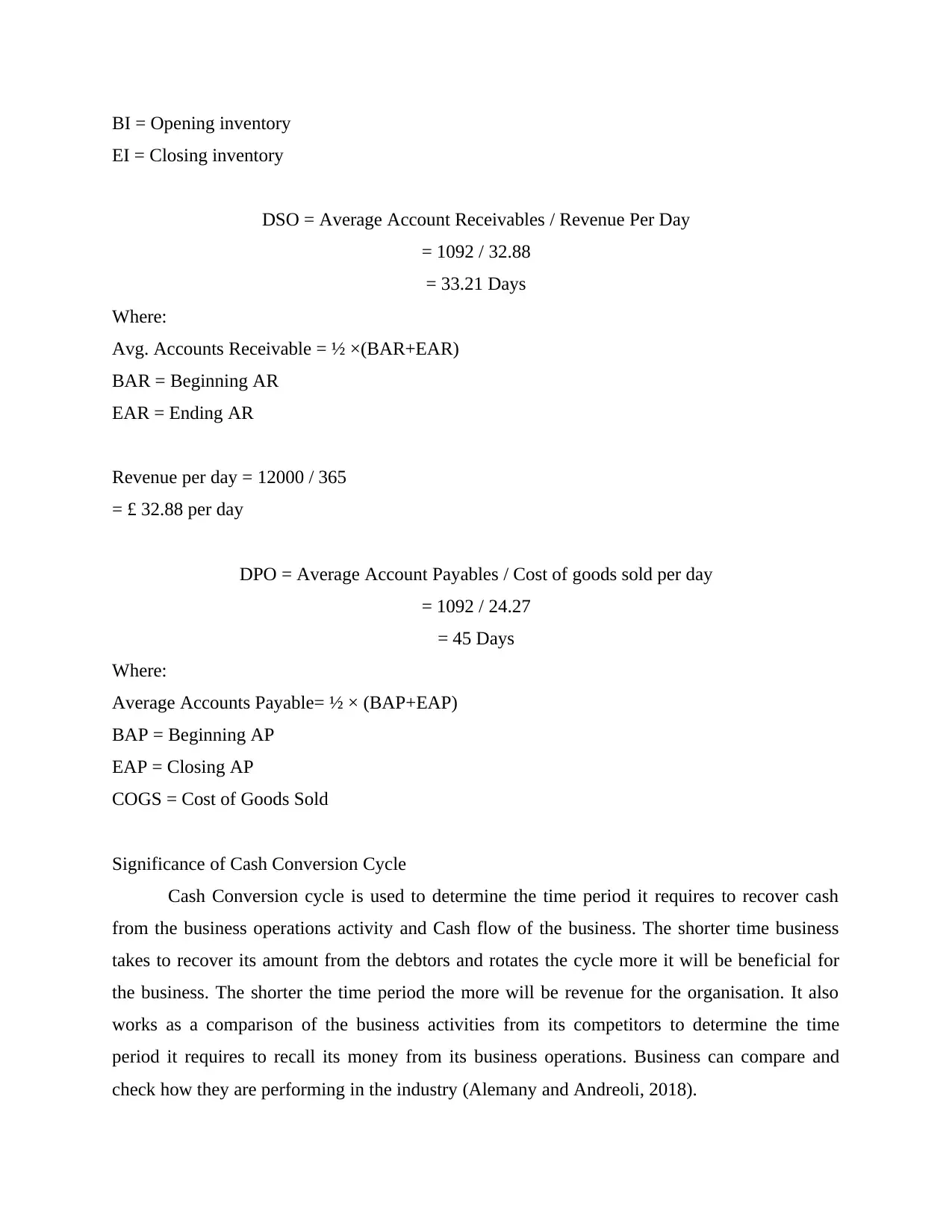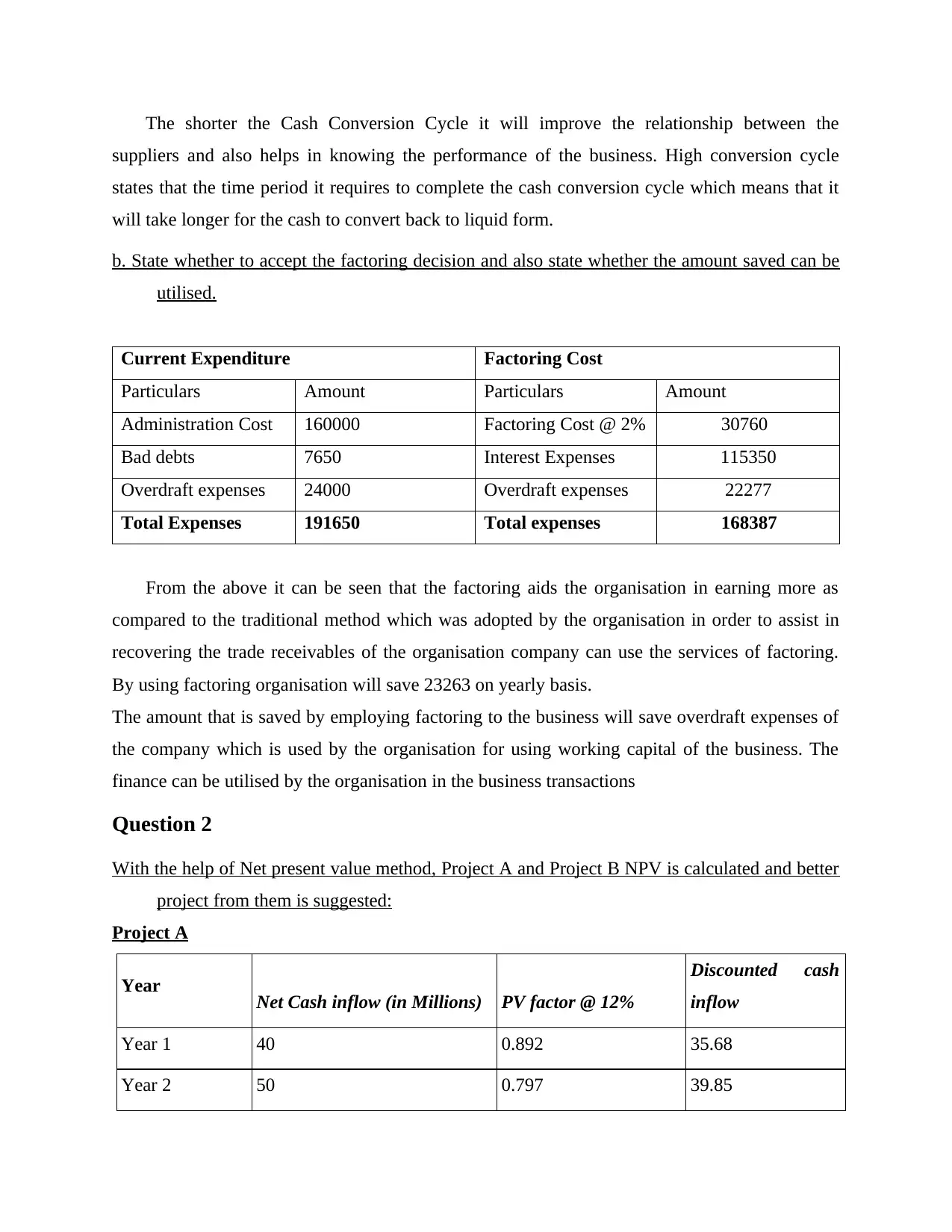Business Finance Assignment - Project Evaluation and Analysis
VerifiedAdded on 2023/06/10
|20
|3128
|106
Homework Assignment
AI Summary
This assignment provides a comprehensive analysis of various business finance concepts. It begins by calculating the cash conversion cycle, which is crucial for understanding a company's liquidity. The assignment then delves into project evaluation, using the Net Present Value (NPV) and Internal Rate of Return (IRR) methods to compare and recommend the best investment project. Furthermore, it addresses the impact of changes in the cost of capital. The assignment also covers the calculation of the Weighted Average Cost of Capital (WACC), including market weightings, and discusses strategies for reducing WACC. Finally, it explores dividend policies, including the determination of annual dividend payments, practical considerations for setting dividend sizes, and the impact of different dividend options on shareholder wealth.

3
Paraphrase This Document
Need a fresh take? Get an instant paraphrase of this document with our AI Paraphraser


⊘ This is a preview!⊘
Do you want full access?
Subscribe today to unlock all pages.

Trusted by 1+ million students worldwide

Paraphrase This Document
Need a fresh take? Get an instant paraphrase of this document with our AI Paraphraser


⊘ This is a preview!⊘
Do you want full access?
Subscribe today to unlock all pages.

Trusted by 1+ million students worldwide

Paraphrase This Document
Need a fresh take? Get an instant paraphrase of this document with our AI Paraphraser

Business Finance

Contents
INTRODUCTION...........................................................................................................................9
Question 1........................................................................................................................................9
Calculate the following:...............................................................................................................9
a) Calculating the Cash Conversion Cycle..................................................................................9
b. State whether to accept the factoring decision and also state whether the amount saved can
be utilised...................................................................................................................................11
Question 2......................................................................................................................................11
With the help of Net present value method, Project A and Project B NPV is calculated and
better project from them is suggested:.......................................................................................11
b) Value of project A and project B evaluated with the help of internal rate of return method.
...................................................................................................................................................13
c)If the cost of capital has seen an increment to 20 percent in 5th year, what will be the advice
then:...........................................................................................................................................14
Question 4......................................................................................................................................14
a) Compute the weighted average cost of capital (WACC) using the market weightings........14
b) There are some justifications described about the company’s structure regarding their
capital and how they can reduce the WACC:............................................................................14
Question 6......................................................................................................................................15
a) The amount of the annual dividend to be paid to shareholders, as well as the practical
considerations to be taken into account when establishing the dividend payment size:...........15
Practical considerations must be made when determining the size of the dividend payment:..15
Effects of the three options given in the question which are related to the wealth of a
shareholder owning 1250 shares in Squeezeco:........................................................................16
CONCLUSION..............................................................................................................................18
REFERENCES..............................................................................................................................19
INTRODUCTION...........................................................................................................................9
Question 1........................................................................................................................................9
Calculate the following:...............................................................................................................9
a) Calculating the Cash Conversion Cycle..................................................................................9
b. State whether to accept the factoring decision and also state whether the amount saved can
be utilised...................................................................................................................................11
Question 2......................................................................................................................................11
With the help of Net present value method, Project A and Project B NPV is calculated and
better project from them is suggested:.......................................................................................11
b) Value of project A and project B evaluated with the help of internal rate of return method.
...................................................................................................................................................13
c)If the cost of capital has seen an increment to 20 percent in 5th year, what will be the advice
then:...........................................................................................................................................14
Question 4......................................................................................................................................14
a) Compute the weighted average cost of capital (WACC) using the market weightings........14
b) There are some justifications described about the company’s structure regarding their
capital and how they can reduce the WACC:............................................................................14
Question 6......................................................................................................................................15
a) The amount of the annual dividend to be paid to shareholders, as well as the practical
considerations to be taken into account when establishing the dividend payment size:...........15
Practical considerations must be made when determining the size of the dividend payment:..15
Effects of the three options given in the question which are related to the wealth of a
shareholder owning 1250 shares in Squeezeco:........................................................................16
CONCLUSION..............................................................................................................................18
REFERENCES..............................................................................................................................19
⊘ This is a preview!⊘
Do you want full access?
Subscribe today to unlock all pages.

Trusted by 1+ million students worldwide

INTRODUCTION
The analysis compares two Better plc projects and calculates the net present value and
internal rate of return of the given data, allowing the company to select one of the best projects
from the two exclusive Better plc initiatives (Artuso and Leamon, 2021). It also suggests that if
the firm's cost of capital increases by 20% in the next five years, the company should adjust its
cost of capital. They find the ex-rights price per share in another query. The hanging valley plc's
net cash raised and the value of its rights, as well as the benefits and drawbacks of the right issue
in the last question, it determines the planet plc's fair price and new pricing. It also identifies a
problem with the dividend growth model of the company.
Question 1
Calculate the following:
a) Calculating the Cash Conversion Cycle
CCC = DIO + DSO – DPO
= 83.13 + 33.21 – 45
= 71.34 Days
Where:
DIO=Days of inventory outstanding
(also known as days’ sales of inventory)
DSO=Days sales outstanding
DPO=Days payables outstanding
DSI = Average Inventory / Cost of Goods Sold * 365
= (2018 / 8860) * 365
= 83.13 Days
Where:
Avg. Inventory= ½ ×(BI+EI)
The analysis compares two Better plc projects and calculates the net present value and
internal rate of return of the given data, allowing the company to select one of the best projects
from the two exclusive Better plc initiatives (Artuso and Leamon, 2021). It also suggests that if
the firm's cost of capital increases by 20% in the next five years, the company should adjust its
cost of capital. They find the ex-rights price per share in another query. The hanging valley plc's
net cash raised and the value of its rights, as well as the benefits and drawbacks of the right issue
in the last question, it determines the planet plc's fair price and new pricing. It also identifies a
problem with the dividend growth model of the company.
Question 1
Calculate the following:
a) Calculating the Cash Conversion Cycle
CCC = DIO + DSO – DPO
= 83.13 + 33.21 – 45
= 71.34 Days
Where:
DIO=Days of inventory outstanding
(also known as days’ sales of inventory)
DSO=Days sales outstanding
DPO=Days payables outstanding
DSI = Average Inventory / Cost of Goods Sold * 365
= (2018 / 8860) * 365
= 83.13 Days
Where:
Avg. Inventory= ½ ×(BI+EI)
Paraphrase This Document
Need a fresh take? Get an instant paraphrase of this document with our AI Paraphraser

BI = Opening inventory
EI = Closing inventory
DSO = Average Account Receivables / Revenue Per Day
= 1092 / 32.88
= 33.21 Days
Where:
Avg. Accounts Receivable = ½ ×(BAR+EAR)
BAR = Beginning AR
EAR = Ending AR
Revenue per day = 12000 / 365
= £ 32.88 per day
DPO = Average Account Payables / Cost of goods sold per day
= 1092 / 24.27
= 45 Days
Where:
Average Accounts Payable= ½ × (BAP+EAP)
BAP = Beginning AP
EAP = Closing AP
COGS = Cost of Goods Sold
Significance of Cash Conversion Cycle
Cash Conversion cycle is used to determine the time period it requires to recover cash
from the business operations activity and Cash flow of the business. The shorter time business
takes to recover its amount from the debtors and rotates the cycle more it will be beneficial for
the business. The shorter the time period the more will be revenue for the organisation. It also
works as a comparison of the business activities from its competitors to determine the time
period it requires to recall its money from its business operations. Business can compare and
check how they are performing in the industry (Alemany and Andreoli, 2018).
EI = Closing inventory
DSO = Average Account Receivables / Revenue Per Day
= 1092 / 32.88
= 33.21 Days
Where:
Avg. Accounts Receivable = ½ ×(BAR+EAR)
BAR = Beginning AR
EAR = Ending AR
Revenue per day = 12000 / 365
= £ 32.88 per day
DPO = Average Account Payables / Cost of goods sold per day
= 1092 / 24.27
= 45 Days
Where:
Average Accounts Payable= ½ × (BAP+EAP)
BAP = Beginning AP
EAP = Closing AP
COGS = Cost of Goods Sold
Significance of Cash Conversion Cycle
Cash Conversion cycle is used to determine the time period it requires to recover cash
from the business operations activity and Cash flow of the business. The shorter time business
takes to recover its amount from the debtors and rotates the cycle more it will be beneficial for
the business. The shorter the time period the more will be revenue for the organisation. It also
works as a comparison of the business activities from its competitors to determine the time
period it requires to recall its money from its business operations. Business can compare and
check how they are performing in the industry (Alemany and Andreoli, 2018).

The shorter the Cash Conversion Cycle it will improve the relationship between the
suppliers and also helps in knowing the performance of the business. High conversion cycle
states that the time period it requires to complete the cash conversion cycle which means that it
will take longer for the cash to convert back to liquid form.
b. State whether to accept the factoring decision and also state whether the amount saved can be
utilised.
Current Expenditure Factoring Cost
Particulars Amount Particulars Amount
Administration Cost 160000 Factoring Cost @ 2% 30760
Bad debts 7650 Interest Expenses 115350
Overdraft expenses 24000 Overdraft expenses 22277
Total Expenses 191650 Total expenses 168387
From the above it can be seen that the factoring aids the organisation in earning more as
compared to the traditional method which was adopted by the organisation in order to assist in
recovering the trade receivables of the organisation company can use the services of factoring.
By using factoring organisation will save 23263 on yearly basis.
The amount that is saved by employing factoring to the business will save overdraft expenses of
the company which is used by the organisation for using working capital of the business. The
finance can be utilised by the organisation in the business transactions
Question 2
With the help of Net present value method, Project A and Project B NPV is calculated and better
project from them is suggested:
Project A
Year Net Cash inflow (in Millions) PV factor @ 12%
Discounted cash
inflow
Year 1 40 0.892 35.68
Year 2 50 0.797 39.85
suppliers and also helps in knowing the performance of the business. High conversion cycle
states that the time period it requires to complete the cash conversion cycle which means that it
will take longer for the cash to convert back to liquid form.
b. State whether to accept the factoring decision and also state whether the amount saved can be
utilised.
Current Expenditure Factoring Cost
Particulars Amount Particulars Amount
Administration Cost 160000 Factoring Cost @ 2% 30760
Bad debts 7650 Interest Expenses 115350
Overdraft expenses 24000 Overdraft expenses 22277
Total Expenses 191650 Total expenses 168387
From the above it can be seen that the factoring aids the organisation in earning more as
compared to the traditional method which was adopted by the organisation in order to assist in
recovering the trade receivables of the organisation company can use the services of factoring.
By using factoring organisation will save 23263 on yearly basis.
The amount that is saved by employing factoring to the business will save overdraft expenses of
the company which is used by the organisation for using working capital of the business. The
finance can be utilised by the organisation in the business transactions
Question 2
With the help of Net present value method, Project A and Project B NPV is calculated and better
project from them is suggested:
Project A
Year Net Cash inflow (in Millions) PV factor @ 12%
Discounted cash
inflow
Year 1 40 0.892 35.68
Year 2 50 0.797 39.85
⊘ This is a preview!⊘
Do you want full access?
Subscribe today to unlock all pages.

Trusted by 1+ million students worldwide
1 out of 20
Related Documents
Your All-in-One AI-Powered Toolkit for Academic Success.
+13062052269
info@desklib.com
Available 24*7 on WhatsApp / Email
![[object Object]](/_next/static/media/star-bottom.7253800d.svg)
Unlock your academic potential
Copyright © 2020–2025 A2Z Services. All Rights Reserved. Developed and managed by ZUCOL.




